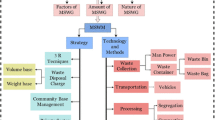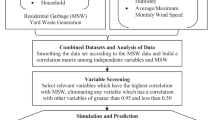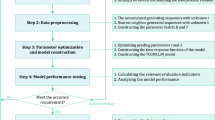Abstract
The massive generation of municipal solid waste (MSW) has become an essential social problem that not only damages the ecological environment but also affects human health. To effectively manage MSW, it is necessary to forecast waste generation accurately. In this study, a grey multiple non-linear regression (GMNLR) model is developed to achieve the effective forecasting of MSW generation in China. Using grey relational analysis (GRA) to rank the influential factors of MSW generation, it is found that urban road area, residential consumption level, and total population are the main factors. Then, these factors are used as the input variables of the model to forecast MSW generation. Meanwhile, four performance indicators with adjusted \(R^{2}\) (\(R_{adj}^{2}\)), absolute percentage error (APE), mean absolute percentage error (MAPE), and root mean square error (RMSE) are used to evaluate the performance of these models. The results demonstrate that the GMNLR model has a highest prediction accuracy among the four models. According to the forecast results, China's MSW generation will reach 332.41 million tons in 2025, with an annual growth rate of 8.28%. The combined model proposed in this paper is helpful for the government in policies and regulations making for MSW management.






Similar content being viewed by others
References
Magazzino C, Mele M, Schneider N (2020) The relationship between municipal solid waste and greenhouse gas emissions: Evidence from Switzerland. Waste Manag 113:508–520. https://doi.org/10.1016/j.wasman.2020.05.033
Yaman C (2020) Investigation of greenhouse gas emissions and energy recovery potential from municipal solid waste management practices. Environ Dev. https://doi.org/10.1016/j.envdev.2019.100484
Ministry of Ecology and Environment of the People's Republic of China. https://www.mee.gov.cn
Du M, Peng C, Wang X et al (2017) Quantification of methane emissions from municipal solid waste landfills in China during the past decade. Renew Sustain Energy Rev 78:272–279. https://doi.org/10.1016/j.rser.2017.04.082
Chhay L, Reyad MAH, Suy R et al (2018) Municipal solid waste generation in China: influencing factor analysis and multi-model forecasting. J Mater Cycles Waste Manage 20:1761–1770. https://doi.org/10.1007/s10163-018-0743-4
Sha’Ato R, Aboho SY, Oketunde FO et al (2007) Survey of solid waste generation and composition in a rapidly growing urban area in Central Nigeria. Waste Manag 27:352–358. https://doi.org/10.1016/j.wasman.2006.02.008
Mwenda A, Kuznetsov D, Mirau S (2014) Time series forecasting of solid waste generation in Arusha City - Tanzania. Math Theory Model 4:29–39
Navarro-Esbri J, Diamadopoulos E, Ginestar D (2002) Time series analysis and forecasting techniques for municipal solid waste management. Resour Conserv Recycl 35:201–214. https://doi.org/10.1016/S0921-3449(02)00002-2
Owusu-Sekyere E, Harris E, Bonyah E (2013) Forecasting and planning for solid waste generation in the kumasi metropolitan area of Ghana: An ARIMA time series approach. Int J Sci 2:69–83
Xu L, Gao P, Cui S, Liu C (2013) A hybrid procedure for MSW generation forecasting at multiple time scales in Xiamen City, China. Waste Manag 33:1324–1331. https://doi.org/10.1016/j.wasman.2013.02.012
Ayeleru OO, Fajimi LI, Oboirien BO, Olubambi PA (2021) Forecasting municipal solid waste quantity using artificial neural network and supported vector machine techniques: A case study of Johannesburg, South Africa. J Clean Prod. https://doi.org/10.1016/j.jclepro.2020.125671
Jahandideh S, Jahandideh S, Asadabadi EB et al (2009) The use of artificial neural networks and multiple linear regression to predict rate of medical waste generation. Waste Manag 29:2874–2879. https://doi.org/10.1016/j.wasman.2009.06.027
Kannangara M, Dua R, Ahmadi L, Bensebaa F (2018) Modeling and prediction of regional municipal solid waste generation and diversion in Canada using machine learning approaches. Waste Manag 74:3–15. https://doi.org/10.1016/j.wasman.2017.11.057
Chen HW, Chang N-B (2000) Prediction analysis of solid waste generation based on grey fuzzy dynamic modeling. Resour Conserv Recycl 29:1–18. https://doi.org/10.1016/s0921-3449(99)00052-x
Franchetti MJ (2012) Development of a solid waste prediction, characterization, and modeling tool for the assessment of manufacturing and service waste management systems. J Solid Waste Technol Manag 38:38–57. https://doi.org/10.5276/JSWTM.2012.38
Ghinea C, Dragoi EN, Comanita ED et al (2016) Forecasting municipal solid waste generation using prognostic tools and regression analysis. J Environ Manage 182:80–93. https://doi.org/10.1016/j.jenvman.2016.07.026
Vivekananda B, Nema AK (2014) Forecasting of solid waste quantity and composition: A multilinear regression and system dynamics approach. Int J Environ Waste Manage 13:179–198. https://doi.org/10.1504/IJEWM.2014.059618
Abdoli MA, Nezhad MF, Sede RS, Behboudian S (2012) Longterm forecasting of solid waste generation by the artificial neural networks. Environ Prog Sustain Energy 31:628–636. https://doi.org/10.1002/ep.10591
Abbasi M, Abduli MA, Omidvar B, Baghvand A (2013) Forecasting municipal solid waste generation by hybrid support vector machine and partial least square model. Int J Environ Res 7:27–38
Xu A, Chang H, Xu Y et al (2021) Applying artificial neural networks (ANNs) to solve solid waste-related issues: A critical review. Waste Manag 124:385–402. https://doi.org/10.1016/j.wasman.2021.02.029
Azadi S, Karimi-Jashni A (2016) Verifying the performance of artificial neural network and multiple linear regression in predicting the mean seasonal municipal solid waste generation rate: A case study of Fars province. Iran Waste Manag 48:14–23. https://doi.org/10.1016/j.wasman.2015.09.034
Ferreira JA, Figueiredo MC, Oliveira JA (2017) Household Packaging Waste Management. In: Gervasi Osvaldo, Murgante Beniamino (eds) Computational Science and Its Applications Applications – ICCSA 2017. Springer, USA, pp 611–620
Sunayana KS, Kumar R (2021) Forecasting of municipal solid waste generation using non-linear autoregressive (NAR) neural models. Waste Manag 121:206–214. https://doi.org/10.1016/j.wasman.2020.12.011
Zhang Y, Xu Y, Wang Z (2009) GM(1,1) grey prediction of Lorenz chaotic system. Chaos Solitons Fractals 42:1003–1009. https://doi.org/10.1016/j.chaos.2009.02.031
Intharathirat R, Abdul Salam P, Kumar S, Untong A (2015) Forecasting of municipal solid waste quantity in a developing country using multivariate grey models. Waste Manag 39:3–14. https://doi.org/10.1016/j.wasman.2015.01.026
Kumar A, Samadder SR (2017) An empirical model for prediction of household solid waste generation rate - A case study of Dhanbad, India. Waste Manag 68:3–15. https://doi.org/10.1016/j.wasman.2017.07.034
Cubillos M, Wulff JN, Wohlk S (2021) A multilevel Bayesian framework for predicting municipal waste generation rates. Waste Manag 127:90–100. https://doi.org/10.1016/j.wasman.2021.04.011
Wei Y, Xue Y, Yin J, Ni W (2013) Prediction of municipal solid waste generation in china by multiple linear regression method. Int J Comput Appl 35:136–140. https://doi.org/10.2316/Journal.202.2013.3.202-3898
Zhang Z, Zhang Y, Wu D (2019) Hybrid model for the prediction of municipal solid waste generation in Hangzhou, China. Waste Manage Res 37:781–792. https://doi.org/10.1177/0734242X19855434
Ramesh N, Ramesh S, Vennila G, Abdul Bari J, MageshKumar P (2016) Energy production through organic fraction of municipal solid waste-A multiple regression modeling approach. Ecotoxicol Environ Saf 134:350–357. https://doi.org/10.1016/j.ecoenv.2015.08.027
Kolekar KA, Hazra T, Chakrabarty SN (2016) A review on prediction of municipal solid waste generation models. Procedia Environ Sci 35:238–244. https://doi.org/10.1016/j.proenv.2016.07.087
Mrayyan B, Hamdi MR (2006) Management approaches to integrated solid waste in industrialized zones in Jordan: a case of Zarqa City. Waste Manag 26(2):195–205. https://doi.org/10.1016/j.wasman.2005.06.008
Zhao W, van der Voet E, Zhang Y, Huppes G (2009) Life cycle assessment of municipal solid waste management with regard to greenhouse gas emissions: case study of Tianjin, China. Sci Total Environ 407:1517–1526. https://doi.org/10.1016/j.scitotenv.2008.11.007
Iyamu HO, Anda M, Ho G (2020) A review of municipal solid waste management in the BRIC and high-income countries: A thematic framework for low-income countries. Habitat Int 95:102097. https://doi.org/10.1016/j.habitatint.2019.102097
Mühle S, Balsam I, Cheeseman CR (2010) Comparison of carbon emissions associated with municipal solid waste management in Germany and the UK. Res Conserv Recycl 54:793–801. https://doi.org/10.1016/j.resconrec.2009.12.009
Honma S, Hu J-L (2021) Cost efficiency of recycling and waste disposal in Japan. J Clean Prod. https://doi.org/10.1016/j.jclepro.2020.125274
Zhang DQ, Tan SK, Gersberg RM (2010) Municipal solid waste management in China: status, problems and challenges. J Environ Manage 91:1623–1633. https://doi.org/10.1016/j.jenvman.2010.03.012
Ding Y, Zhao J, Liu J-W et al (2021) A review of China’s municipal solid waste (MSW) and comparison with international regions: Management and technologies in treatment and resource utilization. J Clean Prod. https://doi.org/10.1016/j.jclepro.2021.126144
Chen X, Geng Y, Fujita T (2010) An overview of municipal solid waste management in China. Waste Manag 30:716–724. https://doi.org/10.1016/j.wasman.2009.10.011
Shapiro-Bengtsen S, Andersen FM, Munster M, Zou L (2020) Municipal solid waste available to the Chinese energy sector - Provincial projections to 2050. Waste Manag 112:52–65. https://doi.org/10.1016/j.wasman.2020.05.014
Kaur A, Bharti R, Sharma R (2021) Municipal solid waste as a source of energy. Mater Today Proceed. https://doi.org/10.1016/j.matpr.2021.04.286
Chu Z, Wang W, Zhou A, Huang WC (2019) Charging for municipal solid waste disposal in Beijing. Waste Manag 94:85–94. https://doi.org/10.1016/j.wasman.2019.05.051
Abbasi M, El Hanandeh A (2016) Forecasting municipal solid waste generation using artificial intelligence modelling approaches. Waste Manag 56:13–22. https://doi.org/10.1016/j.wasman.2016.05.018
Han Z, Liu Y, Zhong M et al (2018) Influencing factors of domestic waste characteristics in rural areas of developing countries. Waste Manag 72:45–54. https://doi.org/10.1016/j.wasman.2017.11.039
Rosecky M, Somplak R, Slavik J et al (2021) Predictive modelling as a tool for effective municipal waste management policy at different territorial levels. J Environ Manage. https://doi.org/10.1016/j.jenvman.2021.112584
Pauliuk S (2018) Critical appraisal of the circular economy standard BS 8001:2017 and a dashboard of quantitative system indicators for its implementation in organizations. Resour Conserv Recycl 129:81–92. https://doi.org/10.1016/j.resconrec.2017.10.019
Liu B, Zhang L, Wang Q (2021) Demand gap analysis of municipal solid waste landfill in Beijing: Based on the municipal solid waste generation. Waste Manag 134:42–51. https://doi.org/10.1016/j.wasman.2021.08.007
Ojeda-Benítez S, Vega CA-d, Marquez-Montenegro MY, (2008) Household solid waste characterization by family socioeconomic profile as unit of analysis. Resour Conserv Recycl 52:992–999. https://doi.org/10.1016/j.resconrec.2008.03.004
Thanh NP, Matsui Y, Fujiwara T (2010) Household solid waste generation and characteristic in a Mekong Delta city. Vietnam J Environ Manage 91:2307–2321. https://doi.org/10.1016/j.jenvman.2010.06.016
Dai C, Li YP, Huang GH (2011) A two-stage support-vector-regression optimization model for municipal solid waste management - a case study of Beijing, China. J Environ Manage 92:3023–3037. https://doi.org/10.1016/j.jenvman.2011.06.038
Oribe-Garcia I, Kamara-Esteban O, Martin C et al (2015) Identification of influencing municipal characteristics regarding household waste generation and their forecasting ability in Biscay. Waste Manag 39:26–34. https://doi.org/10.1016/j.wasman.2015.02.017
Asongu SA, Agboola MO, Alola AA, Bekun FV (2020) The criticality of growth, urbanization, electricity and fossil fuel consumption to environment sustainability in Africa. Sci Total Environ 712:136376
Wang K, Zhao X, Peng B, Zeng Y (2020) Spatio-temporal pattern and driving factors of municipal solid waste generation in China: New evidence from exploratory spatial data analysis and dynamic spatial models. J Clean Prod. https://doi.org/10.1016/j.jclepro.2020.121794
National Bureau of Statistics of China. http://www.stats.gov.cn/tjsj/ndsj
Mattar L, Abiad MG, Chalak A et al (2018) Attitudes and behaviors shaping household food waste generation: Lessons from Lebanon. J Clean Prod 198:1219–1223. https://doi.org/10.1016/j.jclepro.2018.07.085
Cheng J, Shi F, Yi J, Fu H (2020) Analysis of the factors that affect the production of municipal solid waste in China. J Clean Prod. https://doi.org/10.1016/j.jclepro.2020.120808
Liu G, Yu J (2007) Gray correlation analysis and prediction models of living refuse generation in Shanghai city. Waste Manag 27:345–351. https://doi.org/10.1016/j.wasman.2006.03.010
Shi Y, Xu F, Li X et al (2022) Comparison of influence factors on horizontal ground heat exchanger performance through numerical simulation and gray correlation analysis. Appl Therm Eng. https://doi.org/10.1016/j.applthermaleng.2022.118756
Flores-Sosa M, Avilés-Ochoa E, Merigó JM, Kacprzyk J (2022) The OWA operator in multiple linear regression. Appl Soft Comput. https://doi.org/10.1016/j.asoc.2022.108985
Deng J-L (1982) Control problems of grey systems. Syst Control Lett 1:288–294. https://doi.org/10.1016/s0167-6911(82)80025-x
Yang Z, Chen H, Du L et al (2021) Exploring the industrial solid wastes management system: Empirical analysis of forecasting and safeguard mechanisms. J Environ Manage. https://doi.org/10.1016/j.jenvman.2020.111627
Ding S, Dang Y-G, Li X-M et al (2017) Forecasting Chinese CO2 emissions from fuel combustion using a novel grey multivariable model. J Clean Prod 162:1527–1538. https://doi.org/10.1016/j.jclepro.2017.06.167
Zhang C, Dong H, Geng Y et al (2022) Machine learning based prediction for China’s municipal solid waste under the shared socioeconomic pathways. J Environ Manage. https://doi.org/10.1016/j.jenvman.2022.114918
Niu D, Wu F, Dai S et al (2021) Detection of long-term effect in forecasting municipal solid waste using a long short-term memory neural network. J Clean Prod. https://doi.org/10.1016/j.jclepro.2020.125187
Wu F, Niu D, Dai S, Wu B (2020) New insights into regional differences of the predictions of municipal solid waste generation rates using artificial neural networks. Waste Manag 107:182–190. https://doi.org/10.1016/j.wasman.2020.04.015
Kontokosta CE, Hong B, Johnson NE, Starobin D (2018) Using machine learning and small area estimation to predict building-level municipal solid waste generation in cities. Comput Environ Urban Syst 70:151–162. https://doi.org/10.1016/j.compenvurbsys.2018.03.004
Acknowledgements
We are grateful to the editors and anonymous reviewers for their constructive comments on this study. This work was supported by the Doctoral Research Fund of Nantong University (Grant No. 2018-33), the graduate research innovation project of Jiangsu Province (Grant No. KYCX20_2823).
Author information
Authors and Affiliations
Contributions
All authors contributed to the study conception and design. Material preparation, data collection and analysis were performed by RG, HML and HHS. The first draft of the manuscript was written by RG and all authors commented on previous versions of the manuscript. All authors read and approved the final manuscript. Conceptualization: HML; Methodology: RG, DW; Formal analysis and investigation: HHS, DW, DDRA; Writing—original draft preparation: RG; Writing—review and editing: HML, LY; Funding acquisition: HML, HY; Resources: HHS; Supervision: LY.
Corresponding author
Additional information
Publisher's Note
Springer Nature remains neutral with regard to jurisdictional claims in published maps and institutional affiliations.
Rights and permissions
Springer Nature or its licensor holds exclusive rights to this article under a publishing agreement with the author(s) or other rightsholder(s); author self-archiving of the accepted manuscript version of this article is solely governed by the terms of such publishing agreement and applicable law.
About this article
Cite this article
Guo, R., Liu, HM., Sun, HH. et al. Forecasting of municipal solid waste generation in China based on an optimized grey multiple regression model. J Mater Cycles Waste Manag 24, 2314–2327 (2022). https://doi.org/10.1007/s10163-022-01479-6
Received:
Accepted:
Published:
Issue Date:
DOI: https://doi.org/10.1007/s10163-022-01479-6




